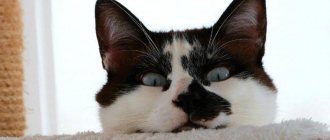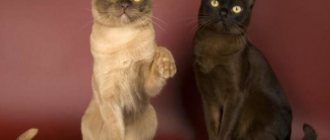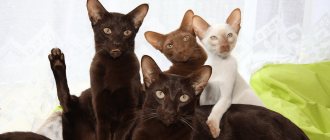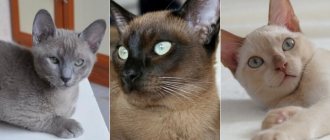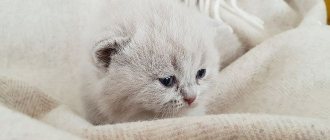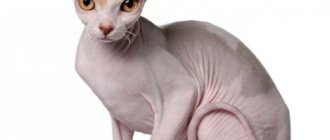History of the Don Sphynx breed
The Don Sphinxes owe their origin to His Majesty's chance.
In 1986, a resident of Rostov-on-Don, Elena Kovaleva, picked up an exhausted stray kitten on the street, which was thoroughly mocked by local schoolchildren. The tiny creature, which turned out to be a cat, was emaciated, and in addition, had a somewhat shabby appearance, which the new owner attributed to lichen. At first, Varvara—that’s the name of the mustachioed, purring creature—didn’t leave veterinarians’ offices. But since the strange baldness stubbornly refused to respond to treatment, the animal was left alone, without becoming interested in the amazing mutation that gave the kitty a hairless back. However, one specialist did show attention to the mongrel foundling, and it turned out to be Irina Nemykina. For several years, the breeder maintained a close relationship with Elena Kovaleva and her ward, and when in 1990 Varvara acquired offspring even more hairless than herself, Irina took one of the kittens, whom she later named Chita. When Chita reached sexual maturity, she was immediately mated with a European Shorthair to produce even more spectacular offspring. The fact is that Varvara’s daughter was not completely hairless and had curly hair on her paws, as well as, although rarely, a pubescent tail. Her kittens were born the same way, which did not stop them from finding their fans and successfully traveling to exhibitions. Soon, the desire to get a completely hairless purr pushed Irina Nemykina into inbreeding, that is, at some point the breeder simply bred Chita with her son, Hannibal. The experiment went well, and in due time the cat brought several babies, one of which turned out to be completely bald and received the nickname Basya Myth.
In 1997, the Don Sphynx was recognized by the WCF, after which the breed began to gain popularity outside of Russia. At the same time, the gene pool of Rostov cats still left much to be desired. Moreover, the unlucky cat family had to be regularly pumped up, involving “third-party producers”, who usually became short-haired European mousecatchers. Only in the early 2000s did the crossing of Don Sphynxes with other breeds begin to gradually fade away, as the number of healthy breeding individuals in domestic nurseries increased noticeably.
Interesting fact: as a result of mating the Don Sphynx with the Siamese, Russian Blue and Turkish Angora, an independent branch of the breed was born - the Peterbald.
Choice of kitten and price
Little Don Sphynx kittens make a fascinating impression on people. Imagine the following picture - plump, naked, folded lumps are constantly tumbling.
They are very curious, which justifies their early intellectual development. One of the features of the Don Sphynx is that kittens open their eyes already in the first 1-3 days of life, and not after 2 weeks, like others.
Regardless of the purpose of the purchase: for yourself, for an exhibition for breeding, you need to make sure that the baby is healthy. He should be active, playful, mobile and clean with a rounded, elastic tummy. The cost of Don Sphynxes is influenced by many factors: the merits of the parents, coat type, gender, class of the animal (for home, breeding, exhibitions), etc.
On Avito, kittens without documents, and therefore without confirmation of breed, are sold at a price of up to 5 thousand rubles.
Pet-class kittens (for castration/sterilization) with documents cost from 15 thousand rubles.
Animals for breeding and show careers can cost from 35,000 rubles. and higher.
Appearance of the Don Sphynx
The appearance of the Don Sphinx evokes strong associations with the Nile Valley, the pyramids and the pets of the pharaohs. And indeed, in appearance, these long-eared purrs dotted with elegant folds are almost no different from the images of the first mousecatchers found in Egyptian tombs. People who have an insufficient understanding of the breed are often confused by the cosmic image of the Rostov cat, forcing them to classify the animals as part of the Canadian Sphynx family. In fact, the relationship between the breeds is zero point one thousandth, but the differences are much greater. Take, for example, the fact that the gene for hairlessness among the “Donets” was and remains dominant, which allows breeders to get hairless offspring even when one of the parents has a full coat. In addition, unlike the “Canadians”, the Rostov sphinxes are already born completely naked, while their overseas counterparts come into this world dressed in, albeit short, but still “fur coats”.
Head
Don Sphynx cats have a wedge-shaped skull with a wrinkled forehead, prominent cheekbones and a convex brow. The muzzle is of moderate length, slightly rounded.
Nose
The straight nose of the Don Sphynx is connected to the forehead through a not very sharp, but quite pronounced transition.
Eyes
All representatives of the breed have wide, almond-shaped eyes, set somewhat askew.
Ears
Large, wide and high, with a pronounced forward bend. The tip of the ear flap is rounded, while its outer edge does not extend beyond the animal’s cheeks.
Vibrissae
The whiskers (whiskers) of the Don Sphynx are thick and curling. In some animals, the hair often breaks off at the root, which is why the cat looks completely beardless.
Frame
The Don Sphynx has a not too long, muscular and dense body, somewhat wide in the croup area.
Legs
Cats' paws are of medium length, with straight forearms and noticeably elongated toes.
Tail
Don Sphynxes have very flexible and long tails without kinks.
Leather
A distinctive feature of the breed is the skin, which in sphinxes is almost hot, elastic, gathering in folds on the forehead, armpits and groin.
Wool
According to the type and structure of the coat, Don Sphynxes are divided into four main types:
- naked (“rubber”) - the animal is completely devoid of hair, its skin is hot, heavily wrinkled, slightly sticky;
- flock - the skin has a very short and thin fur coat, reminiscent of peach fuzz, which disappears over time;
- velor – the pet’s fur reaches a length of 2-3 mm, but as the animal grows older, it falls out, completely revealing the body;
- Brush is the hairiest type of the Don Sphynx, characterized by long, but sparse, coarse and curled hair. Such cats are not allowed into exhibitions, but they are quite suitable for breeding. Usually by the age of two the hair of the brasha falls out, although not always completely.
Color
Don Sphynxes have the right to have any color, that is, they can be snow-white, black, smoky, red, blue and pinkish-red. Tabby-colored individuals are also considered full-fledged representatives of the breed, although they are combined into a separate group.
Defects and vices of the breed
The most common reasons for reducing the score of a show animal are a head that is too narrow, round or short, a weak constitution, a tail that is too short and small ears. Serious defects are considered to be malocclusion (underbite by more than 2 mm) and entropion of the eyelids.
Video
* We invite you to watch a video about the Don Sphynx . In fact, in front of you is a playlist in which you can select and watch any of 20 videos about a given cat breed by simply clicking on the button in the upper right corner of the window. In addition, the material contains quite a lot of photos. By looking at them you can find out what the Don Sphynx looks like.
Rate the material!
[Total votes: 0 Average: 0]
The Don Sphynx is an animal endowed with special charm and beauty. Some consider him ugly, but among true cat lovers there are many admirers of the breed. Don Sphynxes have a soft, affectionate character and an elegant appearance. They are very playful and can create entertainment out of nothing. They get along well with guests and other pets.
The character of the Don Sphynx
In the body of this alien creature hides a very vulnerable soul, yearning for close emotional contact with its owner. So the correct Don Sphynx is unusually soft (as soft as a representative of the cat family can be), not at all jealous and absolutely not prone to aggression. Anyone can offend this good-natured big-eared dog, but no one can make him angry, which makes “Donetsk” dogs ideal pets for families where young tomboys are growing up.
Meek and loving, the Don Sphynx is always happy to receive “calf tenderness,” but if the owner is not yet ready for an open manifestation of feelings, it is not a sin to push him a little. There are a lot of ways to do this, and Rostov cats have mastered almost all of them. In particular, any unoccupied knees in the house will certainly be tested by the Donetsk team for softness and elasticity, and their owner will be caressed to the point of semi-consciousness. At the same time, bald purrs do not suffer from excessive clinginess and do not try to impose their company on someone who does not need it.
In general, Don Sphynxes are moderately lazy creatures, equally willing to devote their free time to both standard cat pranks and lying on radiators. In childhood, they show strong curiosity and activity, but as they grow up, they become somewhat fed up with new impressions and look at life with slight indifference. The peacefulness and non-conflict nature of the breed is already a cliché, so feel free to release parrots, hamsters, guinea pigs and other representatives of the feathered and fluffy world from their cages - the Don Sphynx has nothing to do with them.
It is generally accepted that, intellectually, the “Donetsk people” are somewhat superior to their “woolen” relatives. Indeed, they are incredibly smart and savvy. For example, almost any adult cat knows how to deal with a door latch (long fingers, like those of an alien from an American blockbuster, come in handy here). In addition, they have excellent intuition: the Don Sphynx is always aware of when it is possible to cuddle with its owner, and when it is better to move away so as not to provoke the two-legged master to anger.
Character and habits
The character of the Don pet is soft, affectionate and completely non-conflicting. The breed is sociable and friendly: both towards people and towards other pets. They are easy to train and adapt very well to their living conditions. However, litter box training can present some challenges.
As children, Don Sphynx babies are very playful and inquisitive. With age they become wiser and more balanced. This breed is not at all capable of aggression. She absolutely cannot stand loneliness: if you spend a long time outside the home, then you should not get a Sphynx. He may be very sad and even cry. You should not miss the fact that they are very touchy and are good at distinguishing the intonation in their voice. They are loyal to children and tolerate all their affection. If you decide to invite guests, then do not worry about the hospitality of the Don cat. They get along great and make contact with strangers.
As for the attitude towards the owner, it is impossible to describe: the Don Sphynxes feel his condition well and experience everything with him. They can hug your neck as support, thereby letting you know that you are not alone. You can notice that the Don breed can heal those places where it especially hurts; all this happens intuitively on a subconscious level. From the first minutes you feel their warmth and incredible lightness.
The Don Sphynx cat often chooses its owner. They love to cuddle or watch everything that happens somewhere from above. Do not forget that any pet’s character depends on its content and on the attitude of household members. As it is said in the work of Antoine de Saint-Exupéry: “We are responsible for those we have tamed.”
Education and training
For all her softness and pliability, the Don Sphynx is not alien to aristocratic manners. Moreover, these cats consider themselves equal to humans, so forcing the sphinx to do something against its will is a futile effort. Yes, bald eared cats have a tendency to learn and are even capable of performing simple acrobatic sketches, but only when they themselves want to.
Not the most pleasant feature of the breed is problems with the toilet. It’s not that the Don Sphynx is unable to learn the rules of using a litter box, it’s just that sometimes ancient cat instincts awaken in him, requiring him to immediately “mark” the territory. By the way, most often the owner’s bed suffers from the expansion of the “Donetsk resident”. There is no single way to deal with this behavior, but since you simply must demonstrate dissatisfaction with your pet, shout at the cat or direct a stream of water from a spray bottle at it. The usual oilcloth thrown over the bedspread slightly reduces interest in the master's bed: the Don Sphynxes do not favor pronounced chemical odors and the “aroma” of polyethylene.
Properly raised Don Sphynx cats are not prone to aggression, but the kittens have not yet developed a behavioral model, so during play they often release their claws, damaging surrounding objects, and sometimes even piercing them into someone’s legs. To wean your baby from such an ignoble activity, buy more cat toys and slip them to him every time the tiny bald head starts tearing the wallpaper. Often the cat spoils the interior from banal boredom and lack of attention, in this case, try to devote more time to the pet or get a second hairless purr so that the animals can play together. Spraying some water on a raging hooligan is also not prohibited: it doesn’t hurt and is effective.
Don Sphynxes do not really respect hygiene procedures, so it will take time to eradicate their innate dislike for nail trimming and bathing. To speed up the habituation process, take the space cat in your arms more often, otherwise later you will have to organize a real raid on your pet in order to take it to the bathroom. The usual threatening hissing also brings good results: the animal immediately becomes quiet and stops pumping the driver. In fact, fear is one of the most effective methods of influencing the Don sphinxes. A stern tone, a sudden sharp sound (clap of hands) - and the bald lawless man instantly forgets about his own privilege.
It is relatively easy to instill in your Don Sphynx the skills to properly use a litter tray. Moreover, with some persistence, representatives of this breed can be taught to use the toilet. At first, a separate toilet seat is bought for the cat, which is placed on top of the tray, and the tray itself is placed on a pile of magazines, corresponding in height to the level of the toilet. After the animal gets used to doing its business, leaning on the seat, which can take from several days to a couple of weeks, the bulky structure is removed, leaving a standard toilet at the cat’s disposal.
Description of the breed
These charms have the following characteristics:
- The body size is medium, it is powerful and muscular, with a straight back. Weight is three to six kilograms, boys are larger than girls and can weigh as much as seven.
- The paws are of medium length, slightly rounded at the ends, the toes are long and graceful. The hind limbs are slightly longer than the forelimbs, proportional and slender.
- Medium ponytail, straight and rounded at the tip.
- Wedge-shaped head, flat forehead with vertical folds. Clearly visible cheekbones and eyebrows.
- Medium length straight nose, round and short muzzle with a strong chin. There is a slight pinch and curled vibrissae.
- Large, high-set ears that curve at the top and lean forward.
- Oval or almond-shaped eyes, any color, medium size.
- There are folds on the abdomen and head, and there is excess skin in the groins. The color can be anything.
Velor cuties are covered with delicate fluff, it feels like velor to the touch. When they are first born, they have liquid, thin fur, but then it disappears - this happens in the period from two to twenty-four months.
These creatures are pleasant to stroke and hold in your hands, their body temperature is higher than human, it is forty-one degrees, so they are hot and warming, which is especially good in winter. How great it is to crawl under a blanket with this living heating pad and read or watch a series while listening to the gentle purring!
Maintenance and care
The absence of hair does not yet make the Don Sphynx a comfortable pet. Firstly, the breed has the peculiarity of sweating - yes, these pseudo-Egyptians also smell. In addition, the skin of animals secretes a brownish substance that will have to be removed in time. It is recommended to bathe cats at least once every two weeks using a special shampoo for hairless pets. And since the breed is prone to skin rashes, it is useful to add herbal decoctions (chamomile, chamomile) to the bath. By the way, the water temperature for washing should be at 39-40 °C. In between bath days, discharge and brownish deposits from the skin of the Don Sphynx are removed with a soft cloth soaked in warm water or alcohol-free wet wipes.
The tail and spine area of the “Donetsk” are the places where acne, pimples and boils form, so they are wiped with a ph-neutral lotion. Just remember to rinse the treated areas of skin with water afterwards so that the cat is not tempted to lick off the “cosmetics.” In general, there are a lot of sebaceous glands on the tail of the Don Sphynx, which begin to work in an intensive mode during the period of puberty of the animal. So if, despite your efforts, this part of your pet’s body becomes covered with blackheads (comedones), they will have to be squeezed out. Yes, it’s an unpleasant matter for both the owner and the cat owner, but it’s necessary.
Due to the lack of eyelashes, the eyes of Don Sphynxes are quite vulnerable, so experts recommend washing them once a day, and without using cotton swabs and pads, the fibers of which can get stuck on the mucous membrane. By the way, if, even with systematic care, clear or brownish discharge accumulates in the corners, this is normal. But if the nitrous oxide in the eyes of the “Donetsk resident” has acquired a greenish or yellowish tint, you have a serious reason to look into the veterinary office.
The large, fan-shaped ears of the Don Sphynx quickly fill with wax secretions, so they will have to be cleaned every week. If you prefer to remove wax with lotion, it is better, after instilling it inside, to massage the ear linen a little - this will help the dirt move away from the inner walls faster. Do not fall into perfectionism and do not try to clean the ear of your cat 200% by inserting the cotton swab deeper, otherwise you risk rewarding the animal with sudden deafness.
The claws of hairless cats are long and do not retract completely into the pads of the fingers, so no matter how hard the purr tries, he will not be able to grind them off completely. Arm yourself with a claw clipper and take the initiative, remembering safety measures and carefully avoiding the area where the nerve endings are located. The nail bed also needs to be regularly wiped with a napkin soaked in lotion, as grease accumulates in it. A couple of times a month, the Don Sphynx’s teeth are brushed with fish-flavored veterinary paste or, if your pet is very patient, with soda mixed with a drop of the cheapest red wine.
The Don Sphynxes develop a warm relationship with the sun: the bald purrs love to arrange a solarium for themselves on the windowsill, as a result of which their skin changes color. Sometimes it comes to a real overdose of ultraviolet radiation, so if your pet overexposes to sunbathing, drive him off the windowsill or take him to the shade. Otherwise, you will get an infernal creature with burnt skin, which will come off in rags within a few days. And the Don Sphynxes often freeze, so they have extreme respect for any warm places. So if you are tired of watching a bald charmer cuddle with a radiator for days, sew him warm pajamas or overalls - patterns can be found on the forums of breed lovers.
Feeding
Accelerated metabolism and increased heat transfer, characteristic of the body of the Don Sphynx, require the same increased attention to the animal’s diet. Please note that two meals a day will not be enough for a representative of this breed, so treat the cat at least three to four times a day. An adult cat should consume 150 g of lean meat (beef, veal) per day, which can be successfully replaced by offal a couple of times a week. Fish plays a secondary role in the diet of the Don Sphynx. Several times a month, you can treat your eared fish with boiled fish fillet, but you definitely shouldn’t completely replace meat with it.
Otherwise, the Donetsk team can do everything that other kitties can. In particular, low-fat fermented milk products, cereals in the form of porridges and vegetables in the form of salads. Raw egg yolk is very useful for hairless purrs, but due to its not very positive effect on the liver, it can be given no more than four times a month. Keeping Don Sphynxes dry is also quite acceptable, but if you have already spent money on such an exotic pet, forget about saving on industrial food. The best “drying” option for hairless catfish would be holistic varieties that do not contain synthetic preservatives. If such expenses do not fit well with your budget, lower the bar to premium food, but never stoop to economy options.
Diet
Nutrition plays an important role in the content. Due to the complete or partial absence of fur, pets are forced to expend more energy and effort. Therefore, nutrition should be balanced and energy-intensive. At the same time, do not overdo it and follow the portion. “Dandelions” love to eat, which promises overeating and obesity.
Don cats can be fed both natural food and prepared food. When choosing industrial feed, it is important that it be from the same manufacturer and of high quality. When feeding natural food, the basis of the diet is: lean meat, sea fish, low-fat cottage cheese and other protein-rich foods. Be sure to give vegetables, fruits, and cereals. It is advisable to create an individual diet only after an individual consultation with a veterinarian. If the diet is chosen incorrectly, the animal can quickly develop serious problems with the intestines and stomach.
The nutrition of an adult Don pet and babies differs in many ways. Kittens have a very sensitive gastrointestinal tract, so they should be fed 3-4 times a day, preferably with wet food. More dense foods are introduced with caution and in small portions so as not to cause allergic reactions and intestinal imbalance.
As you know, Don representatives are partial to sweets, especially flour products. You need to be careful about this and try not to indulge in such delicacies. It is worth refraining from feeding the animal from the table: our food is too fatty and contains a lot of seasonings, which is very harmful to health.
Health and diseases of the Don Sphynxes
The Don Sphynx is a relatively young and not the healthiest breed. Predisposition to diseases in cats is usually hereditary and caused by errors in breeding. For example, various kinds of eczema and microphthalmia (improper development of the eyeball), which are often diagnosed in representatives of this family, passed to them from cats born in the early 90s, when the gene pool of the breed was unstable. Another “family” defect that can seriously ruin a “Donetsk resident’s” life is congenital entropion.
Breeders who commit the sin of inbreeding often give birth to kittens with a curved part of the caudal spine. At first glance, the disadvantage does not seem so significant, but if you breed a crooked-tailed purr with a normal cat, you can get a whole litter of real bald freaks. Nipple hyperplasia and mammary cyst are diseases typical only for cats, and the latter disease most often makes itself felt in tortoiseshell-colored individuals. The so-called shortening of the lower jaw (carp bite) is also a fairly common defect among Don Sphynxes. Animals with such a developmental anomaly cannot eat properly and often injure their own palate with their teeth.
Pros and cons of the breed
Don Sphynxes, like cats of any other breed, have not only positive, but also negative traits.
| pros | Minuses |
| Sociable character | Difficulty in skin care |
| Visual appeal | High mortality rate among kittens |
| Predisposition to dermatological diseases |
Don Sphynxes are original hairless cats that look like aliens from another planet. Despite their extraordinary appearance, representatives of the breed have an easy-going and sociable character. All this makes the Don Chak an ideal pet for exotic lovers.
How to choose a kitten
- Don Sphynx kittens are fragile, sickly creatures and often leave this mortal world in infancy. So buying a baby who is under 12 weeks old is a big and unjustified risk.
- Most parents pass on their temperament and character to their offspring, so before adopting a kitten, talk to its dad and mom. What if they are not charming at all, but evil misanthropes?
- Be sure to ask the cattery owner for a veterinary passport for the kitten. The Don Sphynx, which is taken to a new home, must receive a full package of vaccinations.
- Carefully examine every square inch of your potential pet's skin. If peeling or, worse, traces of eczema are found on it, this is a reason to leave the nursery and never return to it.
- Female and male Don Sphynx kittens differ in character. Cats are more independent and curious, and their skin and fur have a stronger odor. Kitties are more affectionate, more enterprising and more inclined to have close contact with their owner.
- The appearance of the young “Donetsk” is not the last selection criterion. When examined, a proper kitten should give the impression of a healthy and neat creature. As much as possible, avoid babies with bloated bellies, signs of diarrhea and pus-filled eyes, as the consequences of poor care in childhood will follow the animal for the rest of its life.
Dimensions and parameters
The Don Sphynx is a cat with a harmonious and graceful physique and a strong skeleton. With its physique and facial features, the Don pet resembles an alien creature.
Body size is average. Height at the withers is 25–30 cm. The male weighs 6–7 kg, the female – 4–5 kg.
Sphynx brushes are divided into three categories based on the thickness of their coat:
- Velor brush. Hairs up to 5 mm long. In an adult cat, the coat becomes flocked: hairs remain on the neck and body.
- Brush point. A newborn kitten has dense fur. After a year of life, the coat is discharged. Short and dense hair remains on the face and tail. The rest of the body is velor.
- Dense brush. The body is covered with dense wool, through which the skin does not show through.
The Sphynx brush can be any color. The most common are red, black, blue, lilac, white, gray, cream, chocolate, and tortoiseshell cats.

